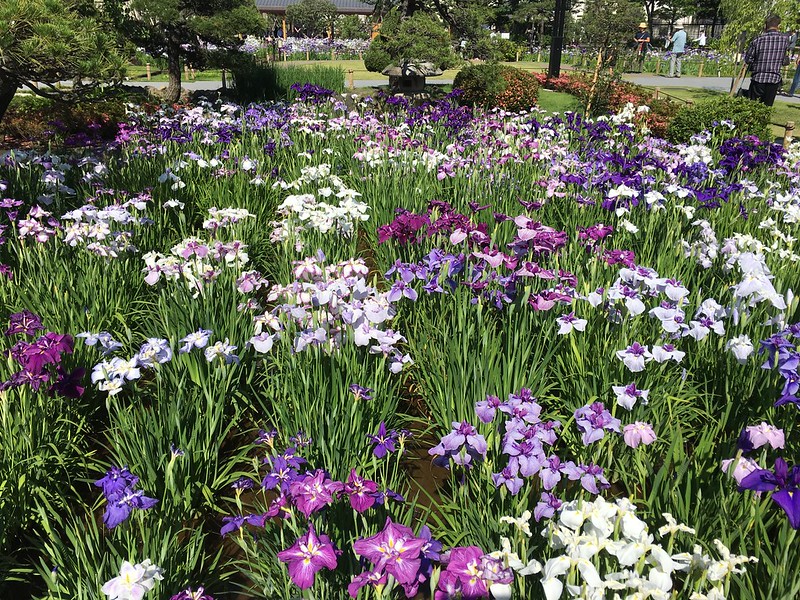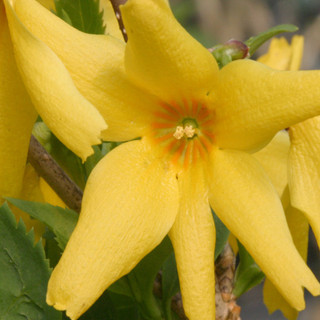Iris is a low-maintenance perennial whose lance-shaped leaves add a striking structural element to a garden. Iris comes in many different heights to suit a wide range of garden sizes. The smallest, Iris reticulata and I. cristata can be grown in containers for a patio or balcony garden, while the giant German Bearded Iris demands to be put at the back of a garden bed where its height can be appreciated against lower-growing perennials and shrubs.
Iris blooms best when grown in a location with at least 6 hours of full sun a day. Partial shade during the hottest part of the day is generally acceptable, but too much shade will prevent blooming and stunt growth. Choose companion plants that thrive in well-draining soil that is not overly rich or loamy, as Iris prefers. Heavy clay is acceptable as long as the drainage is sufficient year-round. Some Irises can tolerate very damp soils and bog-like conditions.
These include Japanese Iris, Siberian Iris, Blue Flag Iris (which is native to North America), and Yellow Flag Iris (which is native to Europe and Asia and considered invasive in most areas of North America). Incorporate these types of Iris into rain garden designs or garden beds that experience seasonal flooding.

Shrubs To Plant With Iris
Iris has a good display of foliage for three seasons of the year and can make a great companion for broadleaf evergreen and blooming deciduous shrubs. Boxwood, juniper, rhododendrons, and azaleas all prefer slightly acid soil, like Iris, and their small, round leaves contrast beautifully with the tall strappy leaves of Iris. Iris blooms from late spring through to the middle of summer and can be used to contrast or complement other blooming shrubs. Dogwood, shrub roses, hydrangea, forsythia, and viburnum are just a few to consider when designing with Iris.

Photo by Mark Wordy, unmodified, Flickr, copyright CC BY 2.0 DEED
Perennials To Plant With Iris
Finding the right perennial to plant with Iris couldn’t be simpler. Any herbaceous or semi-woody perennial that grows in full sun and likes well-drained soil is suitable. Plant Iris in hot dry locations with Russian sage, lamb’s ear, coreopsis, baptisia, and alliums to create a riot of brilliantly colored blooms. Alternately, Iris pairs easily with hyssop, heuchera, columbine, and delphinium to create drifts of flowers that float above their foliage.
Layering early and late blooming perennials in the same bed can extend the color interest through fall. Add a few spring-blooming bulbs like snowdrops, daffodils, crocus, and tulips to fill in space until the Irises have emerged in late spring.

Photo by Mark Wordy, unmodified, Flickr, copyright CC BY 2.0 DEED
Annuals To Plant With Iris
Annuals are great for filling in holes left behind when the early perennials and bulbs finish blooming. Combine brightly colored annuals with stately Irises for a long-lasting, effective display. Snapdragons, cleome, cosmos, and tall types of dianthus make good filler plants in the middle of a garden bed. Trailing and spreading annuals like nasturtium, petunia, moss rose, and calibrachoa give the Iris a colorful spotlight that is easily changed in the following growing season.
Best Companion Plants For Iris in Containers
Smaller varieties of Iris grow quite well in containers for decorating decks or patios. Dwarf Iris (Iris Reticulata) is the earliest blooming and makes a great focal point in a seasonal display with pansies, violas, and other bulbs. Japanese Irises are another good option for containers and bloom typically at the beginning of summer. A container with scaevola, dusty miller, nemesia, and angelonia will provide rich color and texture while remaining low maintenance.
Plants Not To Grow With Iris
Because Irises will grow so easily in a wide range of soil and sun conditions, very few plants are considered bad companion choices. However, shade lovers are some of the few plants that don’t combine well with Irises. Iris requires at least 6 hours of direct sun exposure per day, and will not produce flowers if it is planted in too much shade. Ferns, hostas, brunnera, toad lily, and wood asters require at least some shade to protect their delicate foliage. They also require rich loamy soil that may cause Iris to flop and grow excessive foliage.
Best Plants To Grow With Iris
Use Iris as a focal point in any garden bed or container because of its strong vertical presence and colorful, long-lasting flower display. The full spectrum of colors available for Iris flowers is only rivaled by the large selection of Iris sizes and foliage options. The right plants to add to your design will enhance the Iris’ shape and color, and share Iris’ preference for full to part sun and free-draining soil. Choose from junipers, rhododendron, forsythia, and viburnum for a colorful shrub backdrop to set off a mass planting of Irises.
 |
Author Robbin Small - Published 9-13-2023 |




